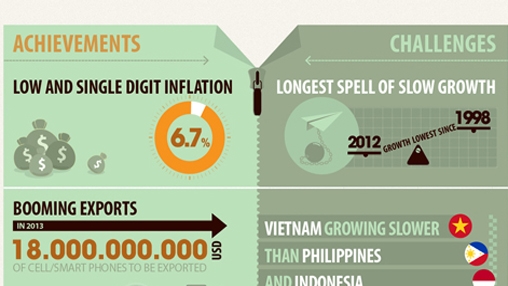ACHIEVEMENTS
- Relatively stable macroeconomic conditions
- Moderate inflation: 6.7% in June 2013.
- Stable exchange rate—Dong depreciated by 1.6% percent in the past 12 months (average exchange rate by commercial banks)
- Significant increase in foreign reserves— from 2.2 months of import cover at the end of first quarter of 2012 to 2.8 months at the end of first quarter of 2013
- Reduced sovereign risks—Vietnam’s credit default swap (CDS) is about 250 basis points in June 2013 compared to about 350 in June 2012.
- Strong external balances
- Solid export growth thanks to strong performance of foreign-invested sector:
Total export value rose by 16% in the first half of 2013 compared to the same period last year.
Foreign invested sector accounts for 66% of Vietnam total exports and grew by 25%
- Diversified export composition: more hi-tech items
Exports of cell phones and parts become the largest export item ($9.9 billion) in the first 6 months of 2013, surpassing Vietnam traditional exports such as crude oil, garment or footwear
Cell phones, electronics and computer together now account for nearly a fifth of Vietnam total exports
- Surplus in trade balance in 2012 – the first ever since 1992.
- Largest current account surplus in country’s history: changed from a current account deficit of 11% of GDP in 2009 to a surplus of 5.9% in 2012; it is projected to remain in surplus in 2013, though will be a lower amount than previous year.
- Mixed signs from foreign investors
- FDI (implemented)/GDP ratio declined from a record 11.8% in 2008 to about 7.7% in the first half of 2013
- Existing competitors are performing better (e.g., Indonesia and Thailand) and new competitors have come up (e.g., Myanmar).
BUT
- Foreign investors still rank Vietnam as an attractive destination for future investments: Vietnam remains one of the most popular destinations for expansion within the ASEAN region according to ASEAN Business Outlook Survey by AmCham and Singapore Business Federation.
CHALLENGES
- Longest spell of slow growth since the onset of economic reforms in the late-1980s Real GDP grew by 5.25 percent (new series) in 2012, the lowest level since 1998
- During 2010-13 period Vietnam will grow at a slower pace than Indonesia and Philippines—first time in two decades.
Declining investment rate, low PMI and slumping retail sales
- Across the board decline in investment rates: Total investment has fallen from 29.6 percent of GDP in the first quarter of 2013 from 38.5 percent in 2010.
- Purchasing Managers Index has remained below 50 marks for most of 2012 and 2013 (PMI below 50 signals contraction in the production)
- Growth in retail sales and services (in nominal terms) has falling from 24% in 2011 to 16% in 2012 and to 11.9% in the first half 2013. - Imports Slowdown
- Imports by domestic sector fell by 7% in 2012, indicating a low demand for capital investment and intermediate goods, as well as weaker private consumption. - Fiscal situation seems to be deteriorating
- State finances are under stress on account of slower growth, lower revenue buoyancy and increased stimulus spending
- Total revenue has fallen from 30 percent of GDP in mid-2000s to an all-time low of 22.8 percent of GDP in 2012 Capital spending (including off-budget) is estimated to have fallen from around 12.6 percent of GDP in 2010 to 7.8 percent in 2012
- External debt remains sustainable because of high current account surplus, but domestic debt is rising fast.
- Slow structural reform: the process just begun but not yet decisively implemented
- An update on banking sector restructuring
- Financial sector remains fragile, but risk of a systemic crisis has receded.
- Restoration of macroeconomic stability and tight credit policy of SBV have prevented the vulnerabilities from growing bigger.
- Establishment of the Vietnam Asset Management Company (VAMC) has so far been the most visible step on the part of the Government to resolve the NPL problems.
- Resolution of NPLs will require a proactive multi-pronged approach. - SOE reforms
- More than two years after the government set out to reform the SOE sector, progress has been limited.
- Work is ongoing to build on the existing legislation to create a comprehensive framework for the management of SOEs.
- Successful restructuring of SOEs will be difficult to achieve without strong inter-agency coordination and improved transparency.
NEAR-TERM OUTLOOK AND RISKS
- Economy expected to grow at a moderate rate of around 5.3 percent during 2013 and 5.4 percent in 2014.
- Inflation is expected to increase to around 8.2 percent at the end of the year.
- There are many downside risks:
- Slower growth may intensify demand for further loosening of monetary and fiscal policies, with the risk of stoking inflationary pressures and reversing the recent gains in macroeconomics stability;
- Delayed implementation of structural reforms could undermine investors’ confidence and worsen growth prospects further.

